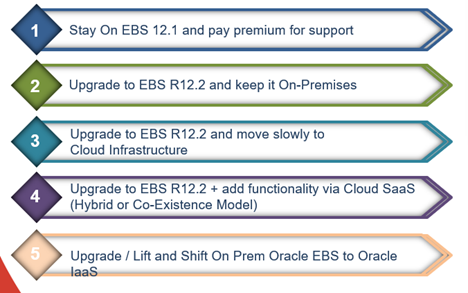Is your organization struggling with Oracle E-Business Suite (EBS) compliance but not currently in the position to move to the cloud?
With Oracle Cloud taking center stage, many think EBS upgrades are no longer in fashion, but for many companies, Oracle EBS upgrades are the way to go. Companies that are unable to move to Oracle Cloud still require access to the latest security, improved user interface, new features, compliance with Oracle Support policies and overall, top performance. The good news is that with the release of Oracle’s latest “Continuous Innovation” model for Oracle EBS 12.2, you can maintain compliance until at least 2032.

In this post, we’ll cover some of the most frequent questions organizations ask us about EBS upgrades. Have questions of your own? Ask us here!
Why upgrade?
While there are various reasons an EBS upgrade rather than a move to the cloud may be the best fit for your organization, the top 3 most common drivers for an upgrade are:
- Oracle has announced it is ending support and pulling the plug on 12.1.3
- The only way to access new functionality and innovation for EBS is via 12.2.X
- Now available online patching allows for faster adoption of features innovation
Who needs an immediate EBS upgrade?
If you are running on older versions of EBS like 11i or R12.1.3, you’re also running out of time. EBS 12.1.3 users will find themselves without support at the close of 2021. Earlier models of EBS, such as 11i, are already out of compliance and no longer eligible for Oracle Support.

What Are the Top Benefits of an EBS Upgrade?
Looking to justify your Oracle EBS upgrade? Our short list for the top benefits of an EBS upgrade are:
- Oracle continues to evolve – Oracle’s commitment to “Continuous Innovation” allows you to position your organization to achieve business goals by leveraging new technology.
- Streamlined installation – E-Business Suite 12.2.X can be installed on existing database servers, significantly streamlining the installation process. It can also be added to existing Real Application Clusters environments.
- Downtime greatly reduced via online patching – You can apply patches to your system while it is still running and fully operational, and while users are still online and can remain online during the patching operation.
- Technical improvements – The introduction of WebLogic Server has resulted in a reduced role for AutoConfig in the configuration of the Oracle HTTP Server and the oacore, oafm, forms and forms-c4ws services.
- Business value increased thanks to enhancements – The creation of Enterprise Command Centers – role-based Business Intelligence dashboards with information-driven navigation by job function – have significantly increased EBS business value.
- Intuitive look, feel and experience – Icon-based page navigation gives version 12.2.X a new look, feel, and user experience.
- Application security – Many companies have identified that hacking and intrusions into networks need to be blocked at multiple levels. It is highly recommended to migrate Oracle EBS 12.1 versions to EBS 12.2 versions to ensure enhanced security.
How long will it take for me to move to an EBS upgrade?
EBS upgrade project timelines depend on the size of the database, number of customizations and commitment from project and business teams. The more interfaces, integrations and customizations, the more time required to retrofit and test the components to make them compliant with the new EBS version. Other factors can also have an impact. For example, if an organization chooses to upgrade the infrastructure as part of the upgrade, additional time is required. A typical upgrade project should be complete within 5-6 months.
Do I need to upgrade my hardware for the upgrade?
Hardware upgrade is dependent upon the current hardware configuration with the client’s EBS systems. The latest version of EBS 12.2 brings in an architectural change with the introduction of Weblogic. This demands certain CPU and memory requirements based on user counts. Another important thing to consider is the Operating System.
Will my finance users or SCM users see a significant difference? Will their user experience improve in any way?
User experience is greatly improved in the new EBS version with a rich, intuitive look and feel and additional functionalities. The newer version comes with the latest industry best practices, and users may be able to retire the existing customizations and use the out-of-the-box standard functionality (ex: tax and regulatory compliance). The existing business processes within various domains are improved with new functionalities and enhancements.
If I have a very customized environment – how do I reduce risk during the upgrade?
In a heavily customized environment, we recommend the use of third-party tools like Config Snapshot & Panaya, which identify all impacts to customizations with the upgrade. These tools can recommend exact changes required to the custom codes. The retrofit activity and testing should be planned accordingly, as that is the longest pole in an upgrade project.
Think a move to the cloud may be a better fit for your organization?
Has your organization taken on a firm cloud-first mindset? An EBS upgrade may still be an option. EBS customers on 12.1 or lower versions have the following options:

Learn More
To learn more about maintaining EBS compliance until 2032 or about transitioning to the cloud, contact our Oracle EBS and ERP Cloud experts at letstalk@nexinfo.com. You can also learn more about this trending topic via our recent OATUG webinar.